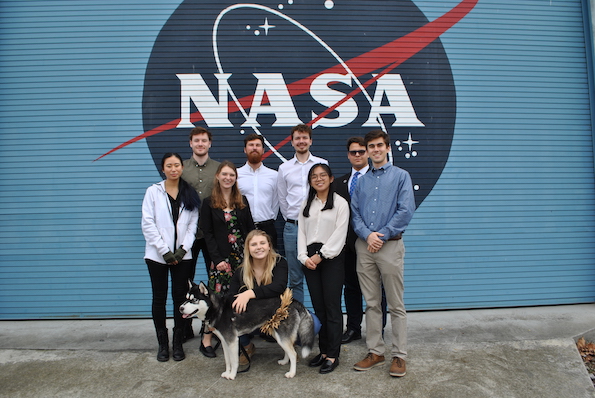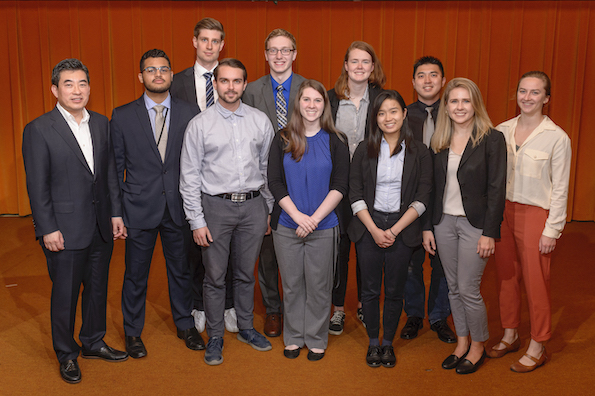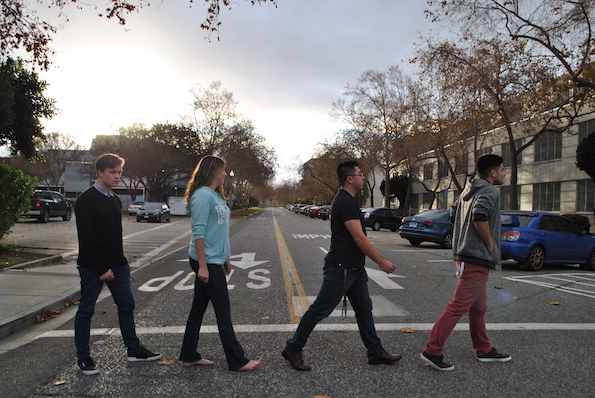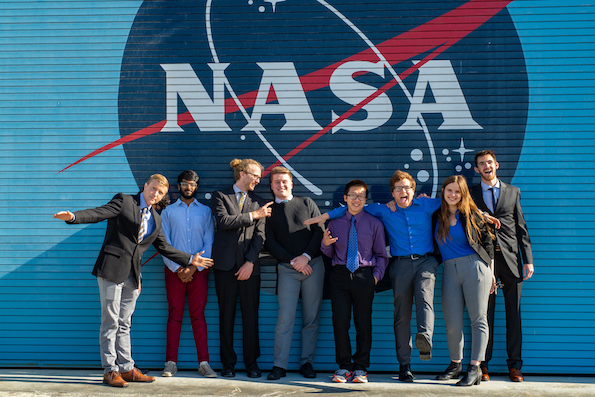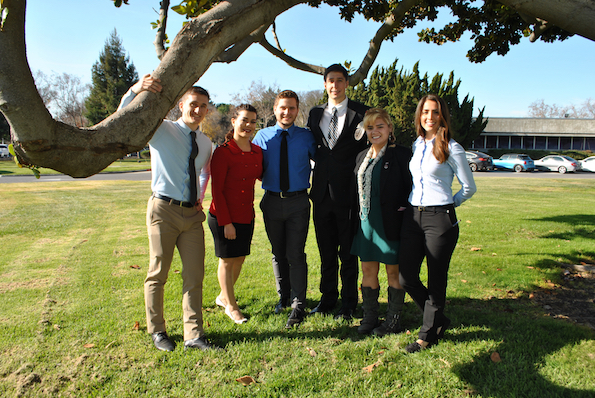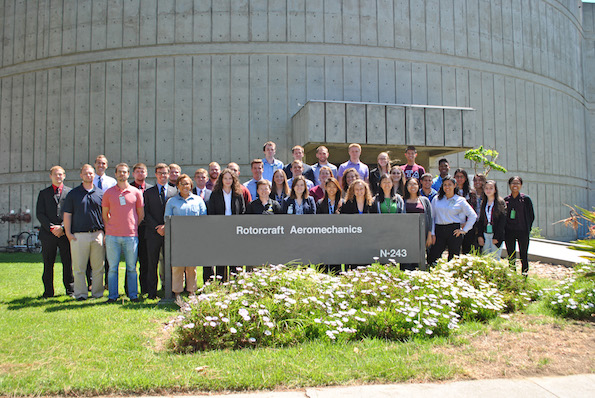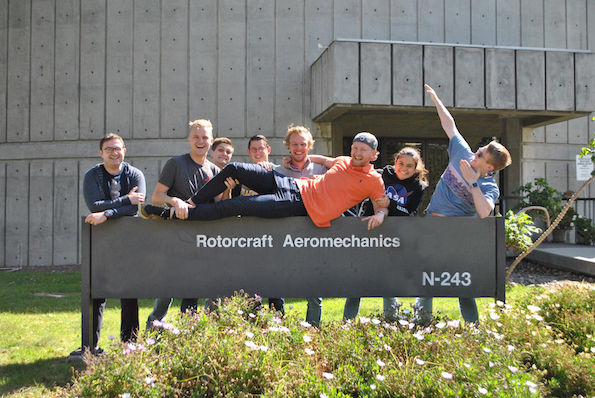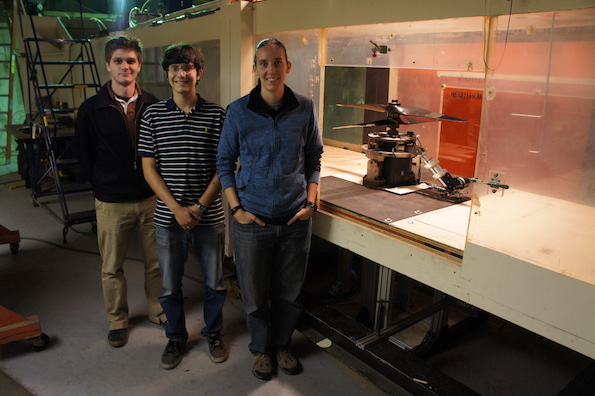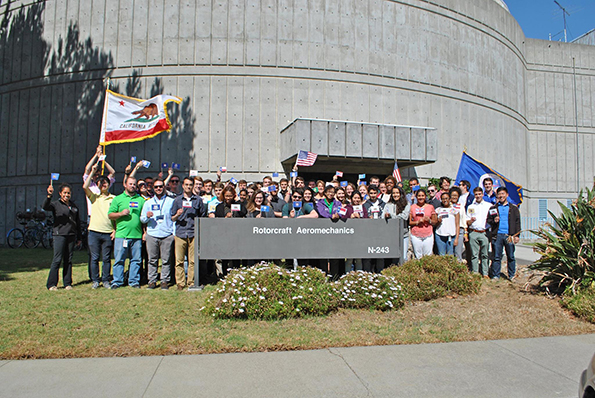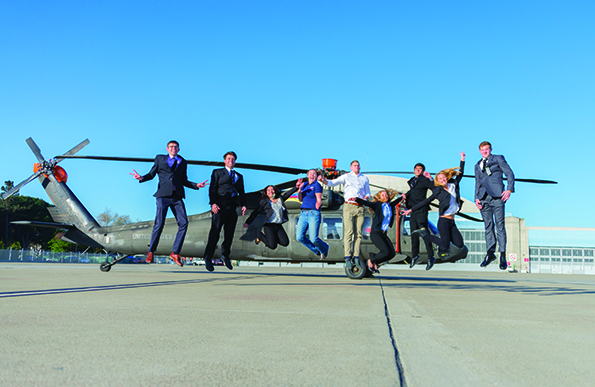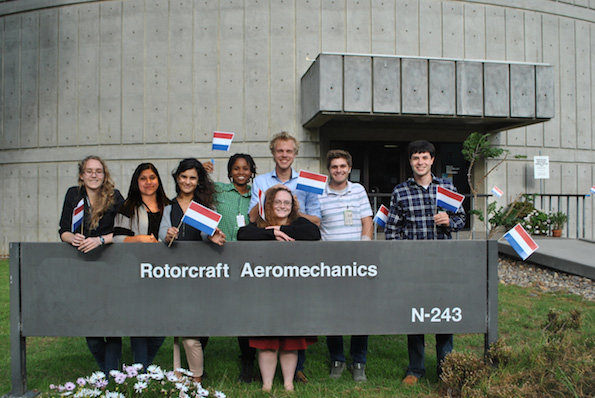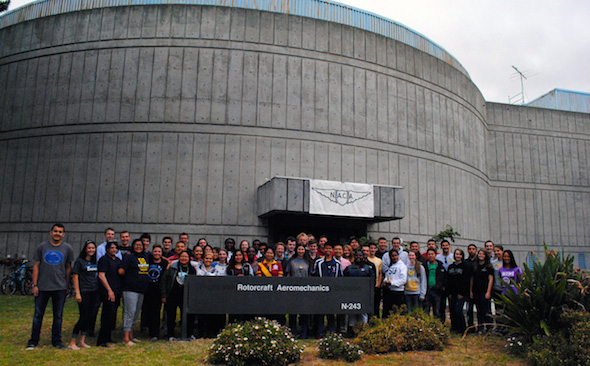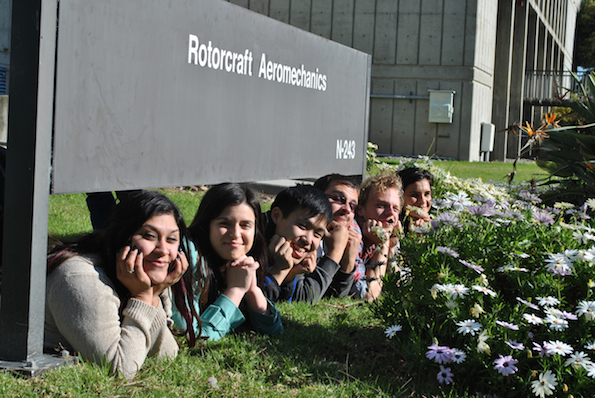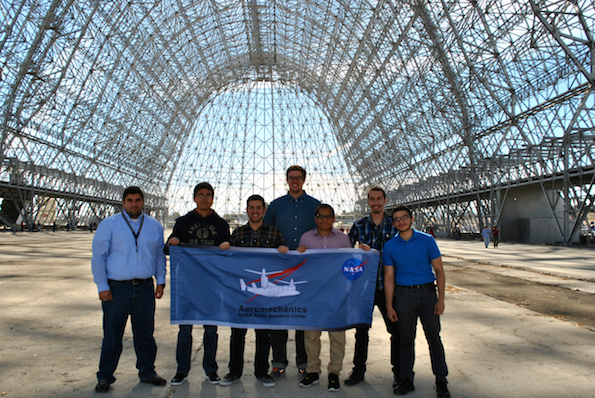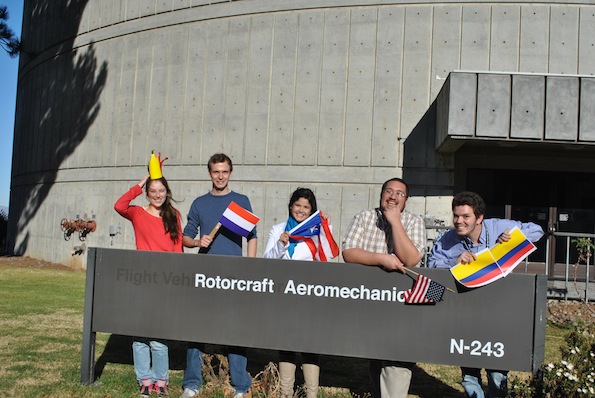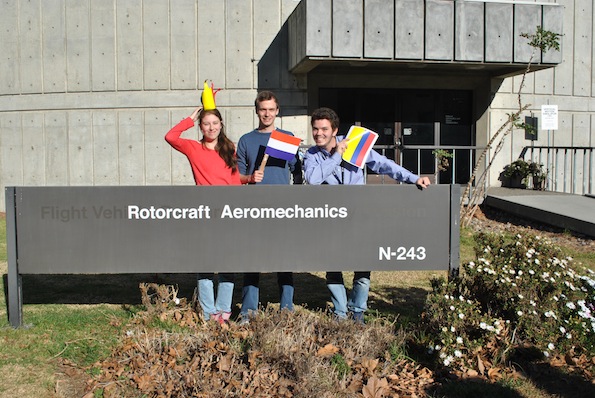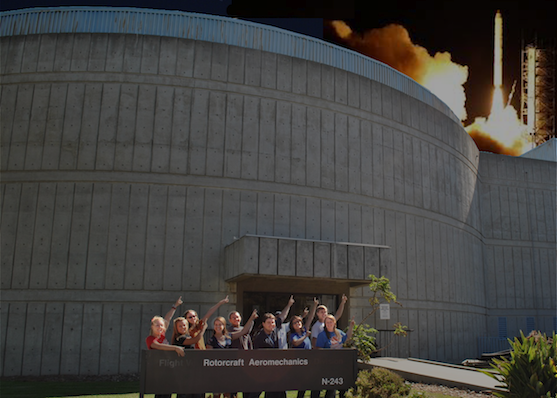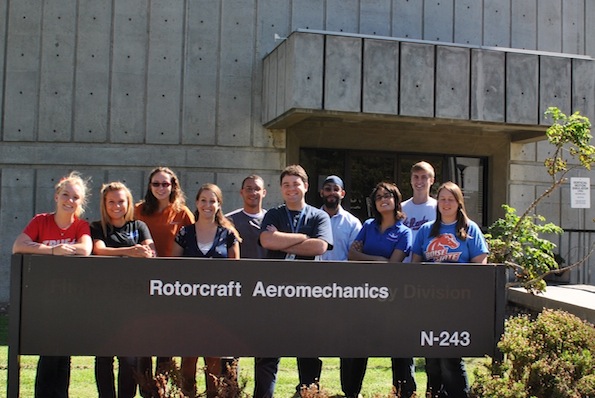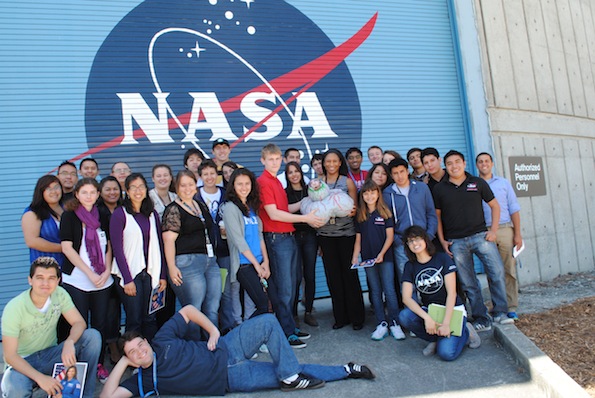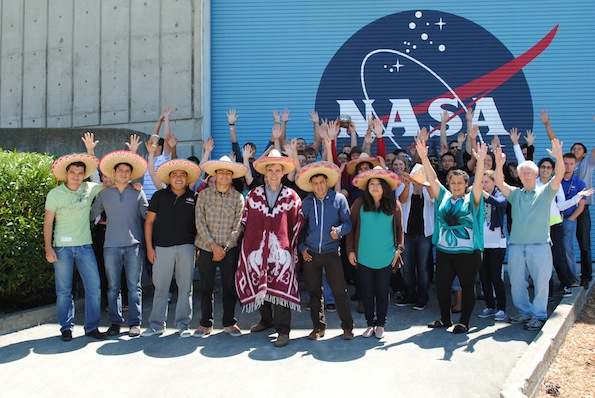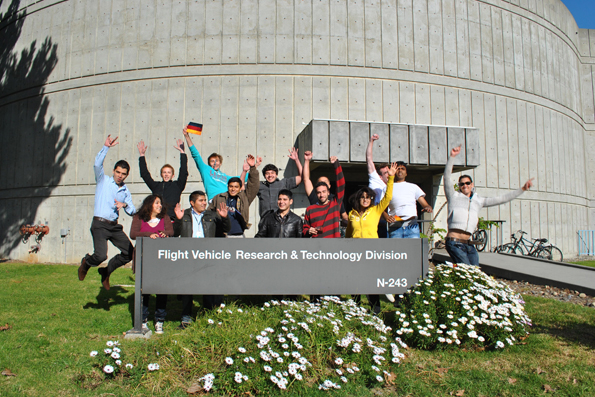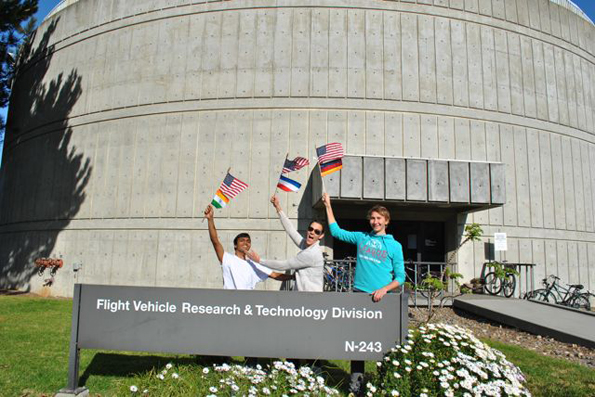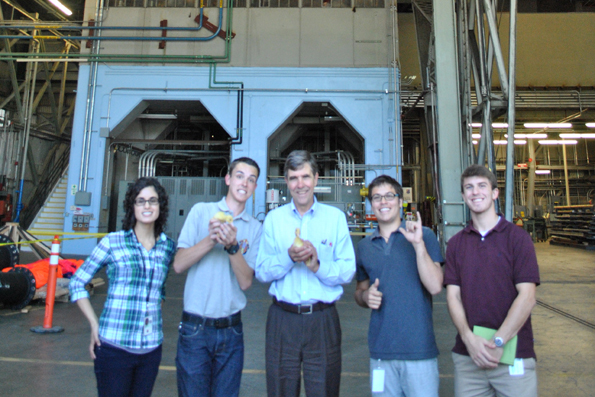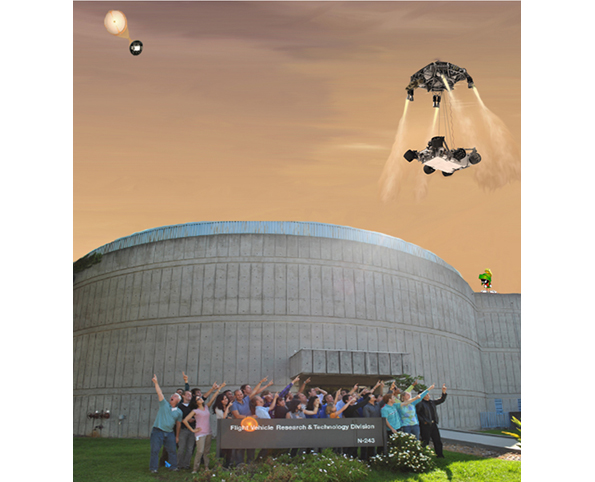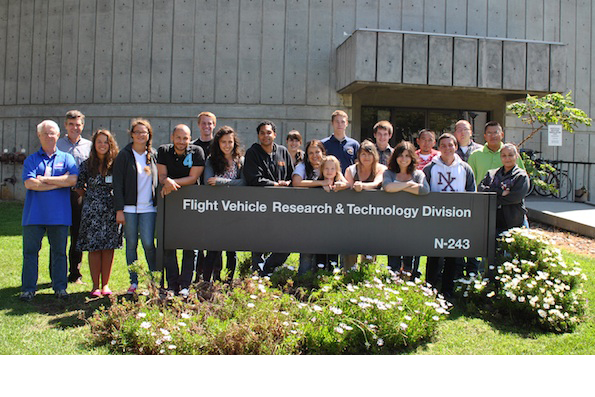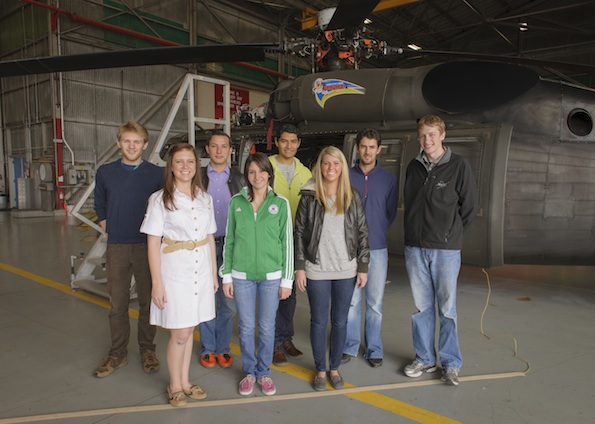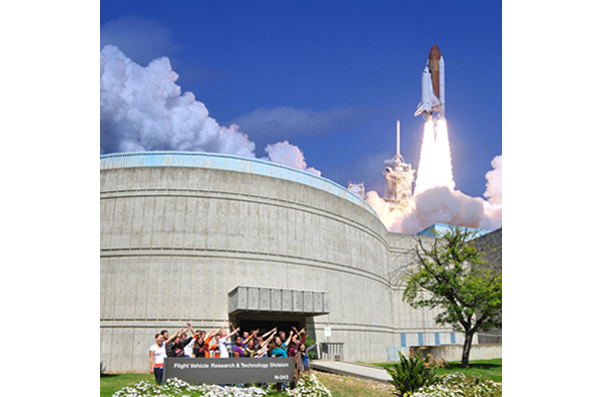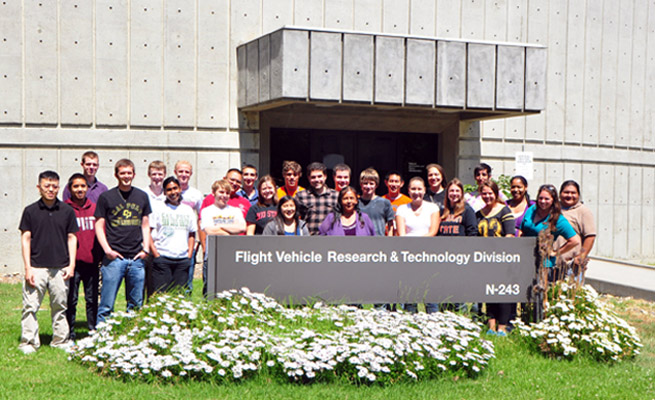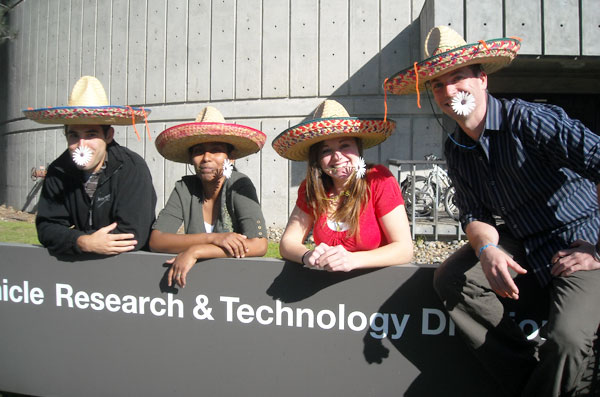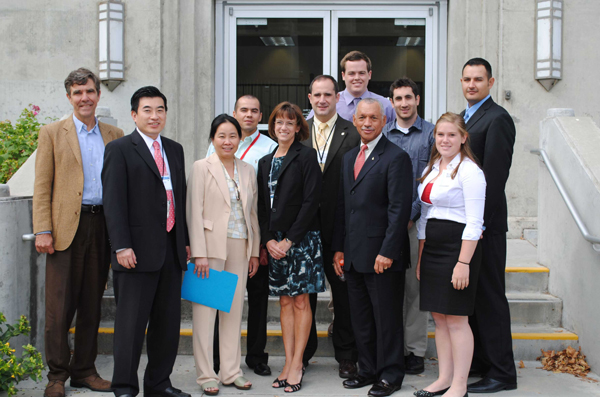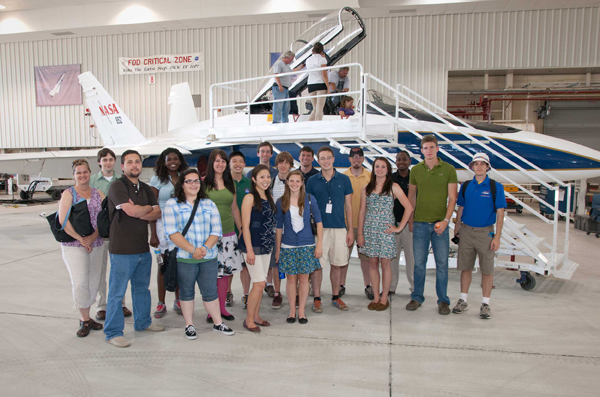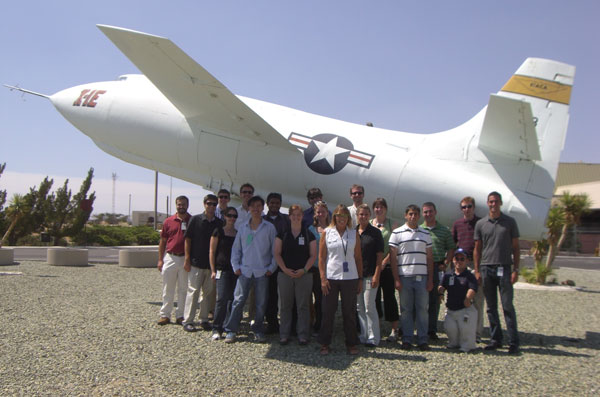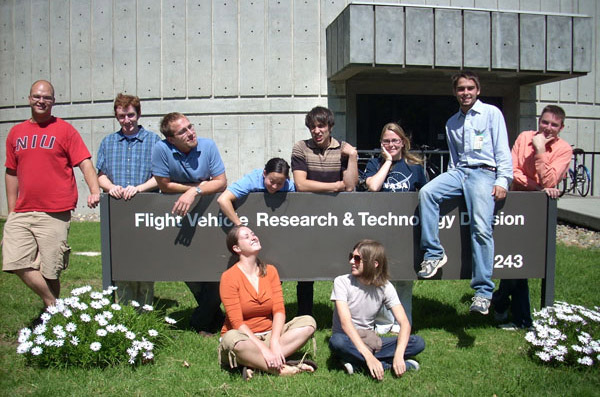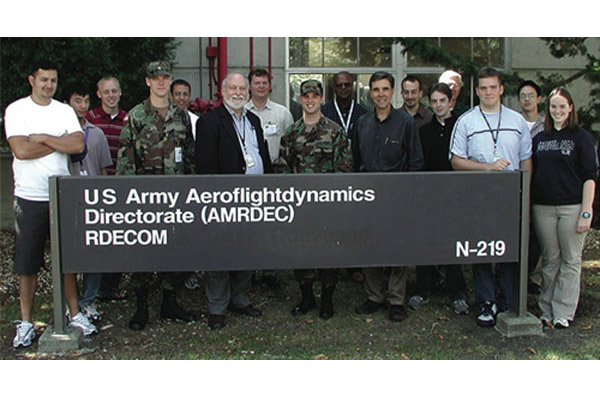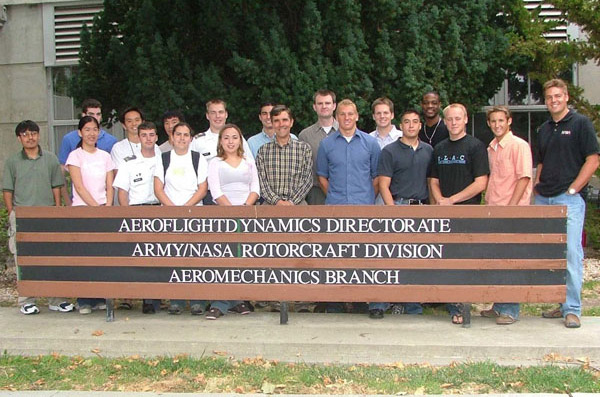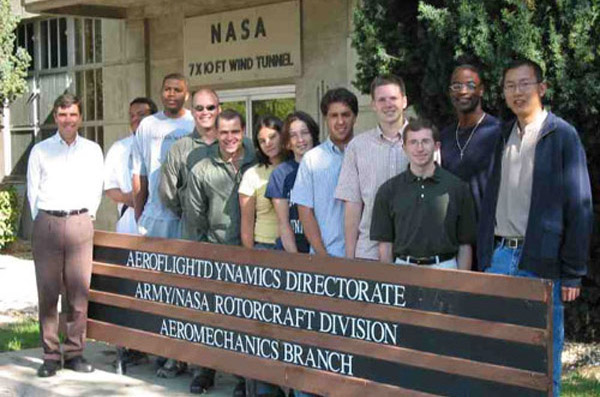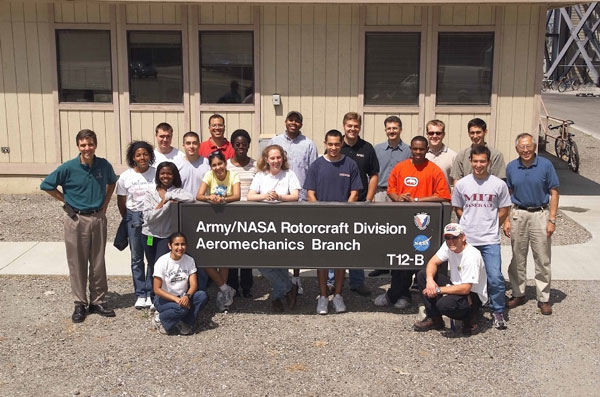STUDENT OPPORTUNITIES WITHIN NASA
What to Do with an Army of Interns
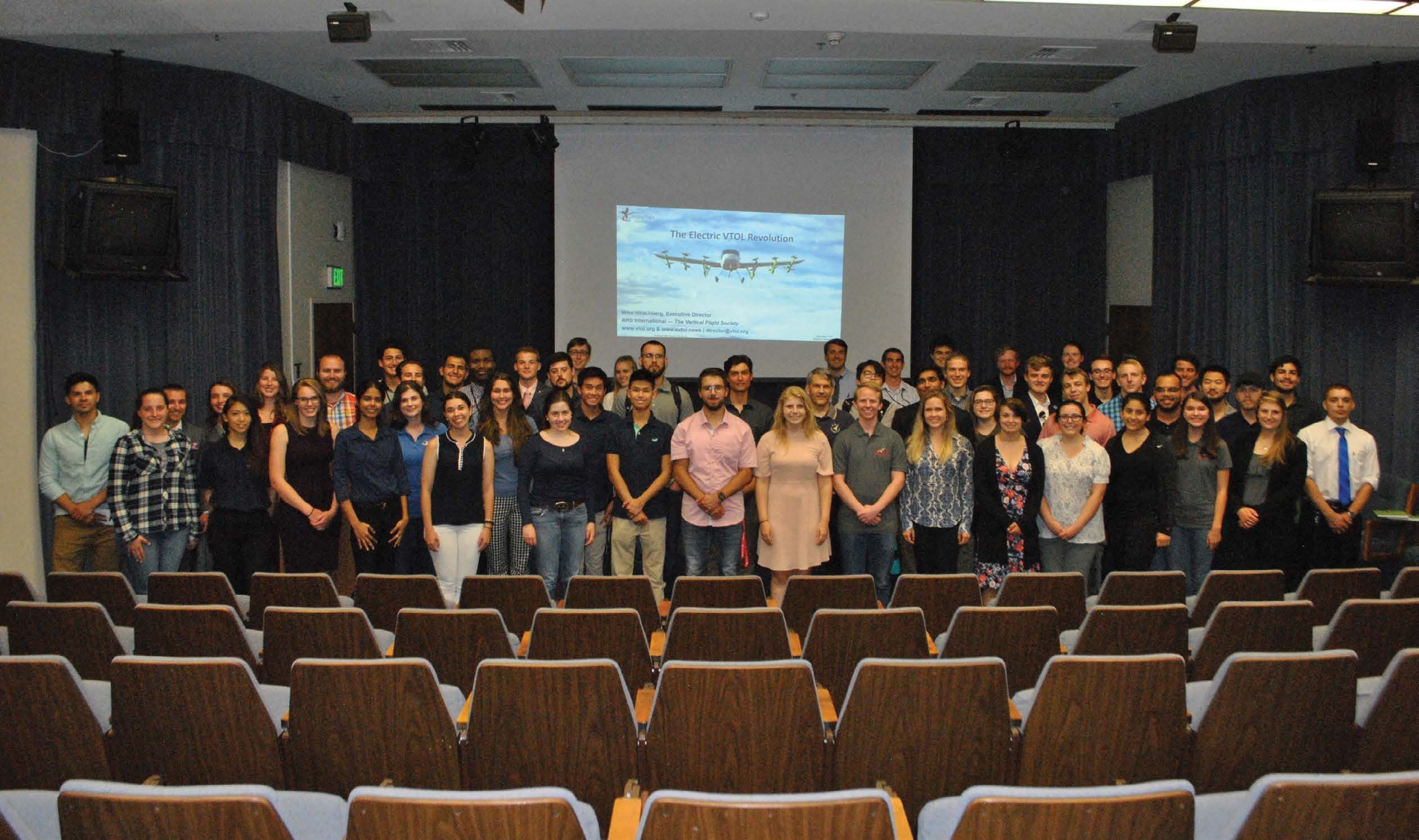
More than 60 NASA Aeromechanics Branch interns attended a local VFS San Francisco Bay Area Chapter meeting at Ames in July. (All graphics courtesy of NASA, except where noted)
By Hannah Dromiack, Class of Summer and Fall 2018
The Vertical Flight Society's Vertiflite Magazine, November/December 2018 download
Throughout history, the same question has been asked by many mentors, from blacksmiths and cobblers to engineers and scientists. Now, at NASA Ames Research Center, it has been answered once again. Over the summer of 2018, the Aeromechanics Branch at NASA Ames Research Center was overrun by over 60 interns with backgrounds ranging from physics and engineering to education, from high school students to graduate students, causing the branch's population to grow by 50%.
The Aeromechanics Branch at NASA Ames Research Center is responsible for aeromechanics research activities that directly support the civil competitiveness of the US helicopter industry and the vertical lift requirements of the US Department of Defense. The Aeromechanics Branch interns were set off to assist with work related to vertical takeoff and landing (VTOL) technology and vertiport counterparts, computational fluid dynamics (CFD), 3D modeling (i.e. computer aided design, CAD), and projects that may even escape this world to Earth's neighbors, Mars and Venus. More than 20,000 man-hours were dedicated to completing over 41 projects.
Reference Models
Fixed-wing VTOL aircraft have capabilities of both rotorcraft and airplanes. They can hover, take off and land vertically, and accelerate to forward flight. This reinvigorated field has the intention of developing new forms of urban transportation that will reduce travel time and environmental impacts from current means of travel. In the pursuit of this goal, NASA created conceptual designs for potential VTOL aircraft with capacities that range from one to 14 passengers, and with fully-electric or hybrid-electric powerplants.
Aeromechanics interns Ethan Krings, Yeray Pabón González and Makynzie Zimmer modeled the NASA conceptual designs and other common reference models with CAD modeling software programs such as SolidWorks and Rhino. This allowed each of the models to be analyzed in RotCFD, a program designed to simulate rotorcraft fluid dynamics, to determine if the design was feasible for its intended use. Models were then 3D printed. RotCFD is an unsteady compressible flow solver that uses Reynolds-Averaged Navier-Stokes equations to model flight characteristics such as lift, drag, power, torque and thrust for flight regimes including takeoff, hover, cruise and landing at different velocities, angles and altitudes. Aeromechanics Branch interns Ali Fares, Lauren Wagner and Curtis Zicker were instrumental in the computational modeling of two of the NASA reference models and one common reference model produced over the summer.
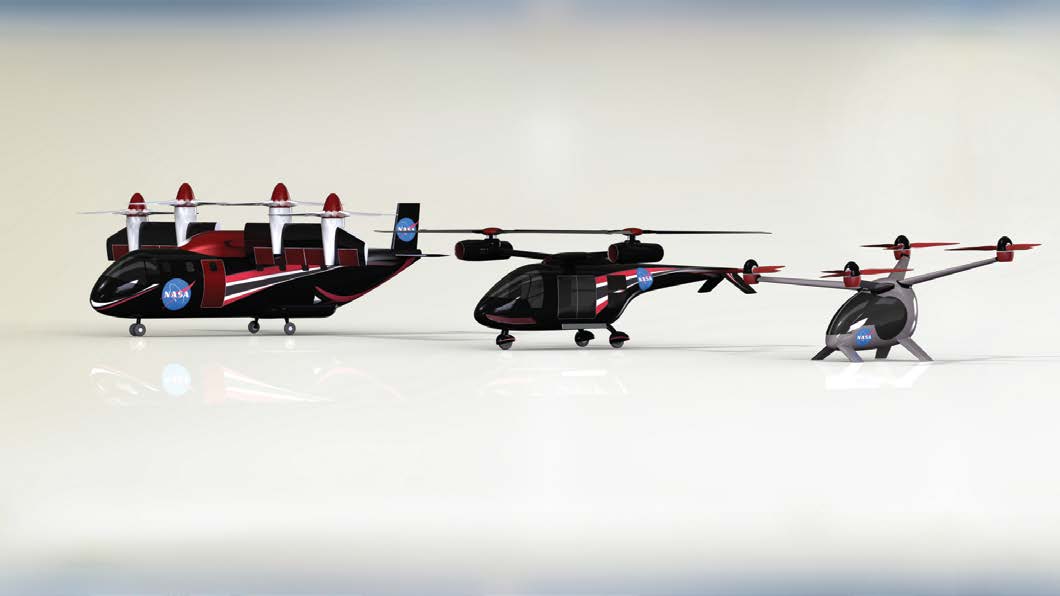
Fares completed computational analysis of the single-passenger, fully-electric quadrotor, NASA Reference Model 1. The simulations analyzed for the quadrotor were done at various atmospheric conditions and angles of attack to determine the overall cruise efficiency of the vehicle.
Wagner assessed the capabilities of the fully-electric NASA Reference Model 2 (the side-by-side configuration) and determined that the side-by-side showed great potential as a VTOL aircraft. The aircraft met the minimum performance requirements set for VTOL technology.
Zicker performed an analysis of the Uber Elevate electric common reference model (eCRM-001), which is fully electric. He determined that under the conditions in his study, the angle of attack of the wing had to be relatively high for cruise flight due to the heavy weight of the aircraft. The aircraft fuselage attitude could still be held at a low angle by setting wing incidence with respect to the fuselage appropriately. In its current form, the model had a lift-to-drag ratio 40% greater than that of a helicopter, making it more efficient in forward flight. However, it produced just enough lift in hover to get the aircraft off the ground. This reference model showed promise as a base for future electric VTOL aircraft; increasing the wing span or wing area would improve its cruise efficiency, while increasing the rotor thrust would improve its hover capabilities.
The computational modeling done by the Aeromechanics interns over this summer — as well as Branch interns in the past — provides a current outlook on the capabilities and feasibility of ideas being produced within the VTOL community, opening the door to further analysis of the future of the field.
VTOL Vertiports
Another important step in implementing urban VTOL aircraft technology is an investigation of the infrastructure needed for efficient and convenient use.
In 2018, Uber held its second annual Elevate Summit and presented vertiport designs that could accommodate the needs of the urban air mobility industry. These new ports may need to accommodate 2,500 vertical takeoffs and landings every hour regardless of most weather conditions. Of the six proposed concepts, the Aeromechanics interns chose to analyze the Uber Hover design from Humphreys & Partners Architects.
Katie Adams, Jacob Kowalski and Michael Swafford used the
eCRM-001 designs supplied by Uber Elevate to create reference
models for RotCFD analysis and to fabricate physical models for
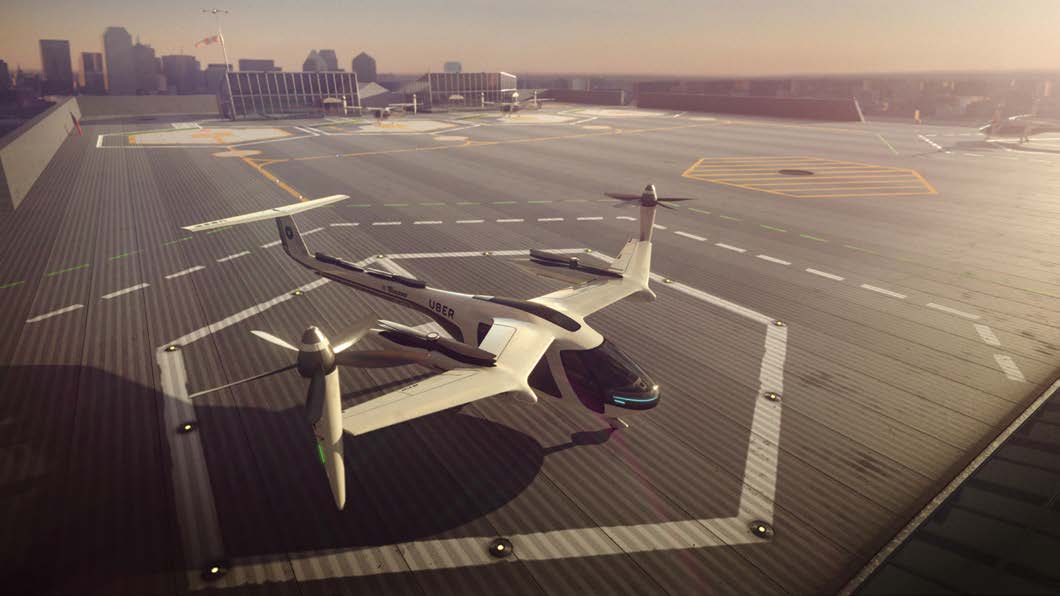
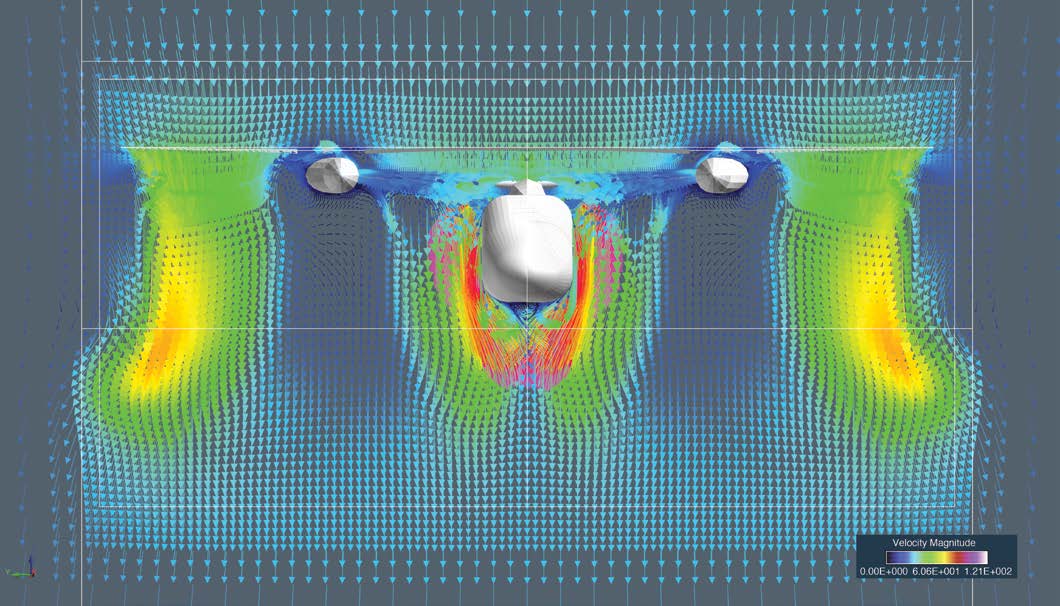
testing in the wind tunnel. The computational analysis showed that the presence of the vertiport did not significantly alter the torque or roll moment exerted by the aircraft's rotors on its center of gravity. However, the pitch moment was changed significantly, with the direction of change being positive in a crosswind and negative in a rear wind. This means that in variable wind

conditions, pilot input would be required to ensure safe landings and takeoffs. Future research for this project will include wind tunnel testing at NASA Ames Research Center, allowing for the comparison of computer simulations with the test data.
Other Uses for VTOL Aircraft
While urban transportation could become the largest industry using VTOL technology, some interns explored alternate uses for unmanned aircraft systems (UAS) technology. Collin Krawczyk, Nathan Mann and Ryan Vedros designed a system to obtain usable food donations from restaurants and grocery stores for transport to food banks and homeless shelters. This project was dubbed ALFRED (Automated Leftover Food Recovery for Extended Distribution). ALFRED's mission is to reduce the amount of food wasted from restaurants or retail stores by facilitating food donations.
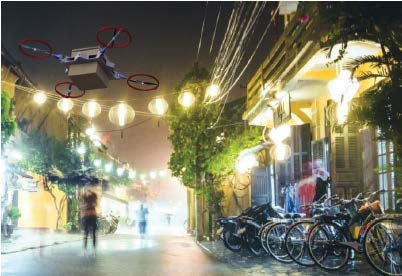
The Aeromechanics interns conceptualized, designed and analyzed the capabilities of this UAS. Their process included three different design, test and evaluation tasks throughout vehicle development: two regarding the method of securing and carrying the load, and one regarding the aerodynamics of the fuselage. Flight capability was analyzed in RotCFD and the project was determined feasible. Future development should include CFD analysis, as well as acoustics analysis, since it will be used in an urban environment.
Mars Helicopter
As we explore new ways of traveling on our own planet, new doors have opened to expand discovery and exploration on other planets. Mars has captured the minds of many humans since its discovery. Mars is our closest neighbor and the planet most like Earth, making it of keen interest. On the upcoming Mars 2020 mission, in addition to sending another nuclear-powered rover similar to Curiosity, the very first Martian rotorcraft will be deployed. In the past, Aeromechanics interns have performed CFD analysis to determine the flight capability of the Mars Helicopter in the Martian atmosphere. This summer, significant contributions were made by Natalia Perez, Nathan Jensen, Chris Byron and Dorsa Shirazi in the analysis of the helicopter's aerodynamics within the Planetary Aeolian Laboratory Martian Wind Tunnel. Tests performed included running the rotors at a variety of RPMs over different pressures ranging from one atmosphere down to Martian conditions. This data was then used to characterize the rotors' behavior in Martian conditions.
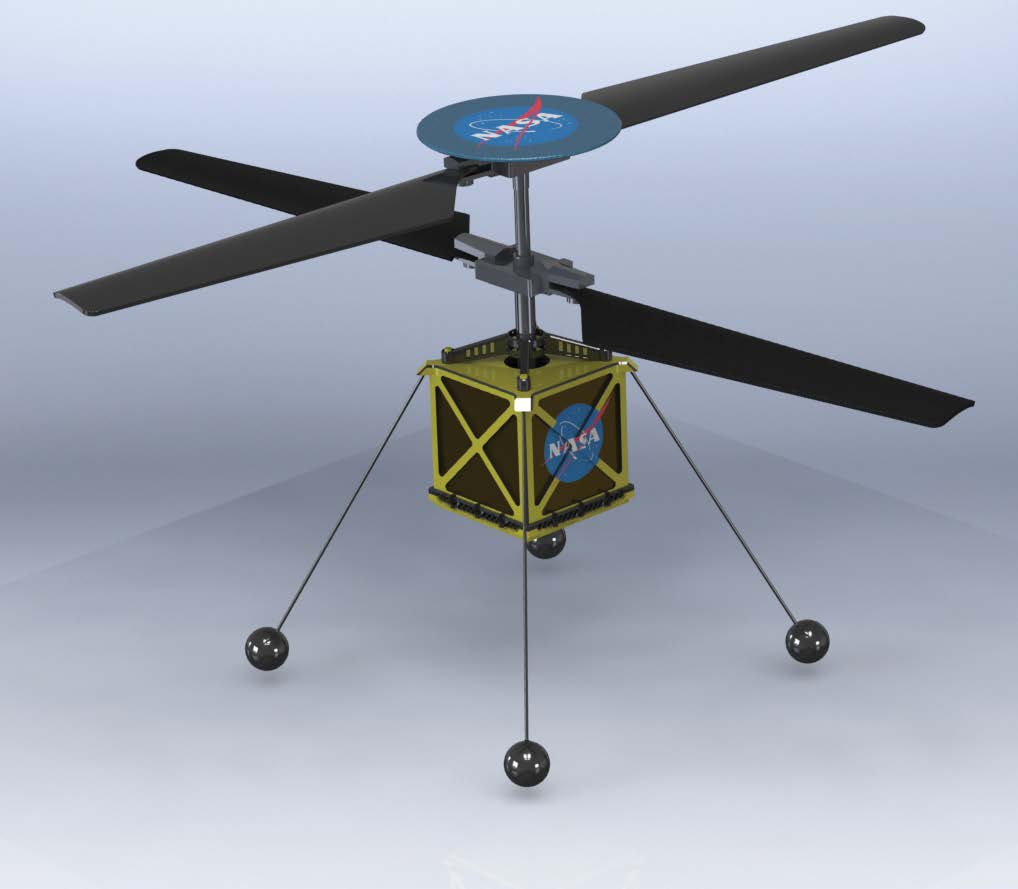
Aeromechanics interns also designed their own Mars Helicopters to be used for educational purposes. Two kits were designed — one for elementary school and one for high school — allowing students to build their own working models of the Mars Helicopter. The first was designed for younger students; it is made from Legos and has a working set of rotors, but it won't leave the ground. The second kit, designed for more advanced students, allows them to build a functional model of the Mars Helicopter. This kit has 3D printed parts for the body, an onboard computer and a full assembly of electronics to control the vehicle. This gives students a taste of how engineering is done and what goes into the building of the next generation of exploratory vehicles.
The Effects of an Army
The ancient Chinese philosopher Lao Tzu, the founder of Taoism, proffered: "Do the difficult things while they are easy and do the great things while they are small. A journey of a thousand miles must begin with a single step." This quote represents the efforts of the summer 2018 Aeromechanics Branch interns. Many of the projects they worked on are ideas and concepts in their infancy, yet to be tested in the real world. These efforts have led to a better understanding of this growing field, and how it will inevitability change the world.
So, what do you do with an army of interns? You march them down a path that could change the world.
About the Author
Hannah Dromiack is a fourth-year undergraduate student studying physics at Arizona State University. Her internship with the NASA Ames Research Center's Aeromechanics Branch runs from June to December 2018. Her projects included data analysis of both the UH-60A Airloads Program and rotor behavior at Martian atmospheric pressures, and assisting in wind tunnel testing of the NASA Tiltrotor Test Rig.
What Else to Do with an Army of Interns
NASA Ames Research Center (ARC) Aeromechanics Branch hosted more than 60 interns this summer and focused their energies on studying the future of vertical flight. This is the second of two reports from this past year's summer interns.
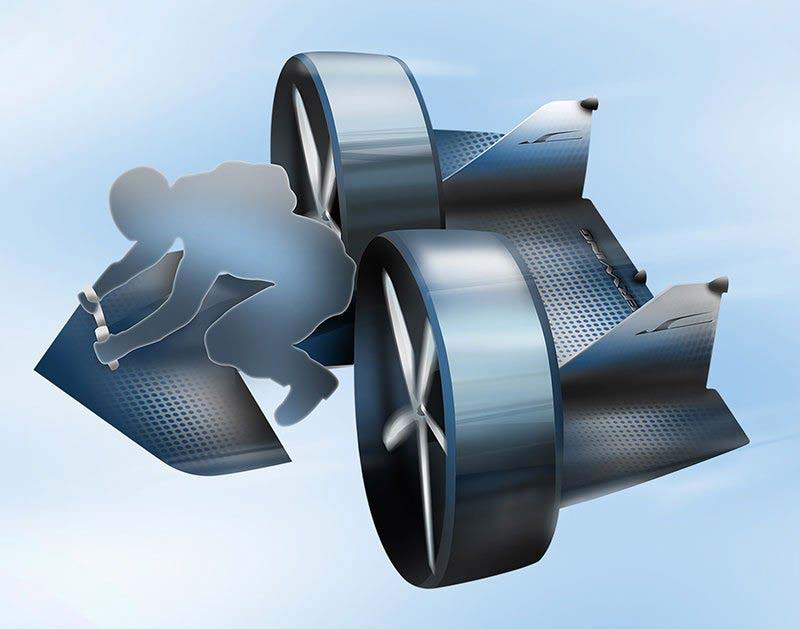
By Nicholas Peters, Class of Summer 2018
The Vertical Flight Society's Vertiflite Magazine, January/February 2019
During my ten-week NASA Aeromechanics Branch internship, I focused on what is considered by some as the most ambitious and ground-breaking new market of the modern aviation industry: urban air mobility (UAM). Even before The Jetsons' first appearance on TV in the early 1960s, the world has hungered for a possible future of commuting to work by sky. Yet, what started out as a fantasy has slowly turned into an increasingly urgent need. The world traffic issues faced in megacities is one that results in the loss of billions of dollars a year of productivity and one that only continues to worsen with time (see for instance, "Traffic Congestion Costs Americans $124 Billion A Year, Report Says," Forbes, Jan. 25, 2015).
It is this impending megacity gridlock that has led to the business case for not only the UAM field but an overarching goal across the industry to establish alternative forms of transportation for the modern urban environment. Yet, with each of these plans, there are selective enabling technologies that act as limiters to their mass market application, and the UAM market is no different. Currently, eVTOL.news – the VFS website on electric vertical takeoff and landing (eVTOL) aircraft – lists more than 125 proposed UAM-styled aircraft established by companies ranging from startups to the largest players of aviation (e.g. Airbus, Bell, Boeing and Embraer). Nearly all of these concepts propose using enabling technologies such as fly-by-wire-based control laws, electric or hybrid propulsion, and advanced structures and manufacturing techniques.
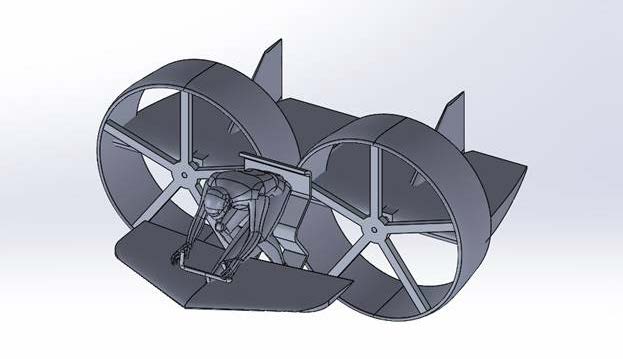
With a large array of technologies still needing to be studied, there is a clear need for a financial incentive to speed the practical application of these technologies. Here is where the GoFly Prize enters the UAM field. The GoFly competition requires that selected teams design and fly minimally-small "personal flying devices" that can incorporate VTOL technologies into their design (see "GoFly Enters Phase II," Vertiflite, July/Aug 2018 or www.goflyprize.com). While each team is competing for $2M in prizes and the hopes of developing a marketable product, the collective information provided by the teams will form the foundation on which a future UAM market for individual transportation could grow.
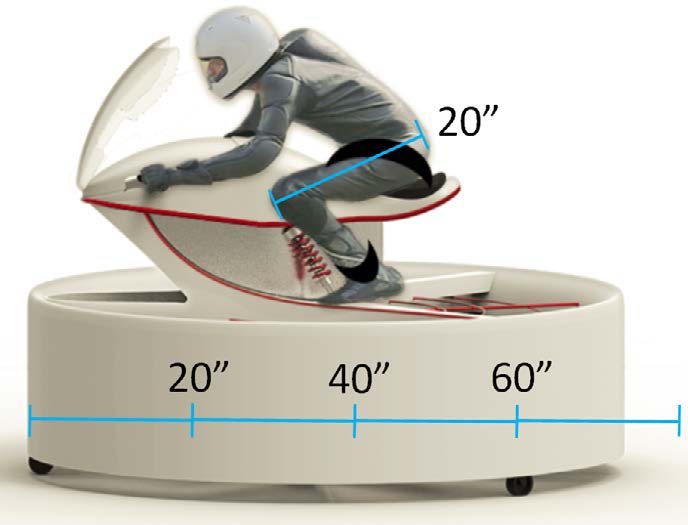
|
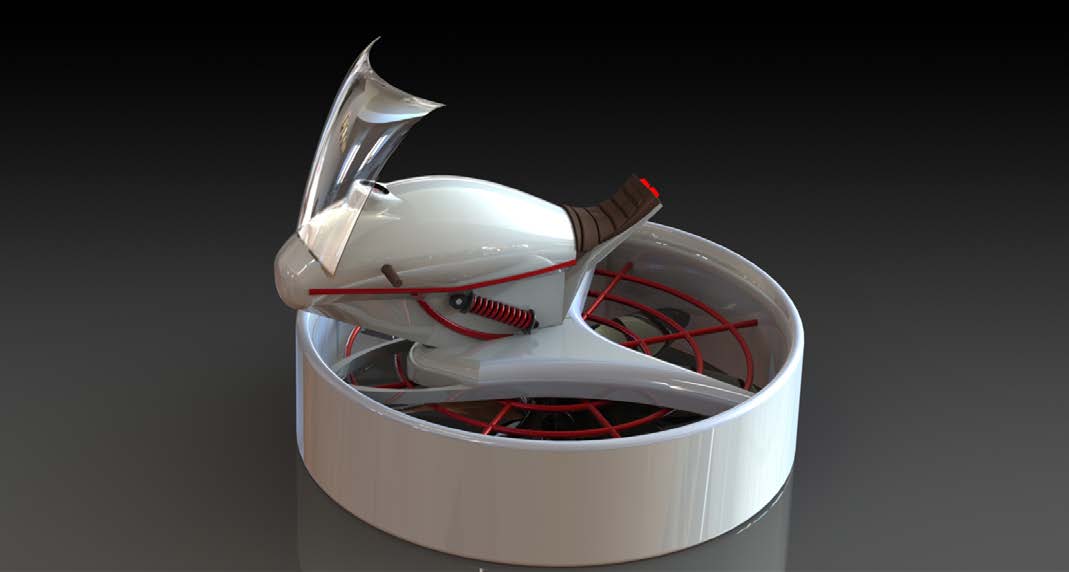
|
To date, the competition has completed its first phase and has selected 10 winners. It is clear that these teams were selected both because their proposed aircraft represented a practical demonstrator and because they appeared capable of seeing their project to completion. However, what may not be so clear is the feasibility of each aircraft selected. With new proposals for eVTOL aircraft being posted on the eVTOL.news directory on almost a daily basis, the rotorcraft community has the opportunity to consider the feasibility of these aircraft. In his Sept/Oct Vertiflite Commentary, "Beware the Hyper-Hype Cycle," VFS Executive Director Mike Hirschberg warned of over-expectation: "While a few early entrants – most notably Ehang, Joby Aviation, Kitty Hawk, Opener and Volocopter – have conducted robust flight testing, including manned flights, the vast majority of innovators are still discovering the unique challenges of vertical flight." A lack of analysis into potentially unrealistic claims made by emerging manufacturers could possibly lead to an over-expectation of where the UAM field currently is. This could potentially lead to a hindrance of the market in the long run. As such, the internship directors decided that it would be worthwhile to dedicate a significant portion of the summer program for my peers and me to conduct feasibility analyses of each of the Phase I winning aircraft for the GoFly competition.
Before feasibility could be considered, the team of interns first had to accurately model each of the ten winners. These reconstructed models for the aircraft were based on images open to the public. In attempting to properly scale these models, the teams positioned 3-D computer models of pilots based on average-sized adults into the aircraft for use as a reference. It should be noted that many of the images initially used as the templates were designed with more emphasis on artistic rendering than on practical engineering (for competitive reasons the teams weren't required to provide accurate images). Given this, it was evident that some of the components of the aircraft would need to be sized through computational analysis. As such, a low-fidelity conceptual design process was undertaken that would provide the team with power and fuel requirements for the aircraft based off a simple mission with a one-minute hover and 20 minutes of cruise. The basic objective of this step was to complete an energy balance by first finding the power required for each flight condition and then, with power and time, determining the energy required for the total mission.
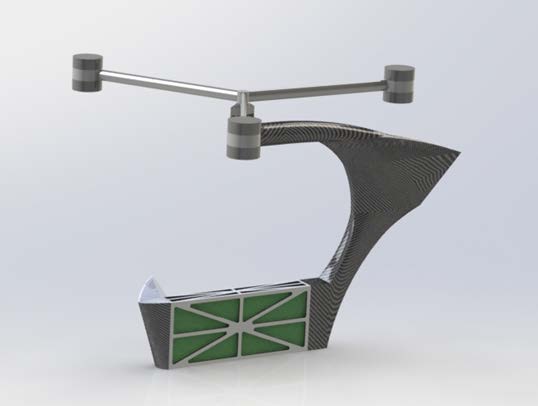
However, before a conceptual mission analysis could be completed, the team first needed an initial estimate of weights to start their energy balance. This initial guess was completed by applying materials to the computer-aided design (CAD) solid models in Dassault Systèmes Solidworks and finding material weights. After the mission analysis was completed, the team took its findings for fuel weights and power requirements, and resized its aircraft with the necessary volume for both the properly-sized motors and fuel. This iterative process was repeated until the change in volumes were small enough to be considered converged.
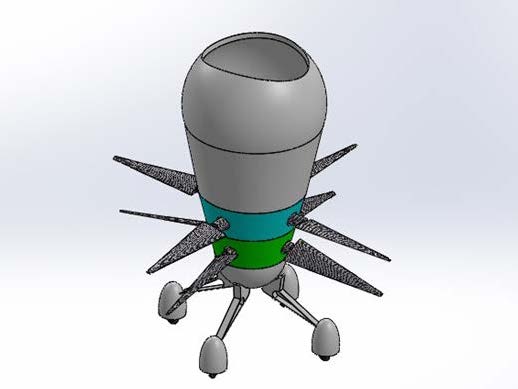
At the conclusion of this analysis, there were no red flags raised warning against feasibility for any of the ten aircraft. However, there was much that was not considered by this simple energybased weight balance that still needed to be considered. There was minimal consideration of component sizing, structures, safety margins, rotor-to-rotor interactions, controllability, etc. In short, only the bare minimum was considered and as such it became evident that a much deeper analysis was needed in order to validate the feasibility for these aircraft with more certainty. To this end, the NASA Design and Analysis of Rotorcraft (NDARC) conceptual design software was employed.
I would like to recognize the modeling group whose work allowed for the feasibility analysis of all 10 aircraft. Their hard work also helped me to obtain as accurate as possible geometric inputs for the NDARC software without having to obtain the actual CAD models from each GoFly team. These team members were Makynzie Zimmer, Ethan Krings, Michaela Sorrentino, James Gayton, Lauren Wagner, Hannah Dromiack and Mireille Fehler. As part of a summer high school program, two high school interns also contributed to the project: Bianca Ortiz-Larios and Courtney Young.
By the end of the ten-week internship, all 10 aircraft had NDARC files constructed with estimated weights and sizes. To maintain the integrity of the competition, the specific numerical results from this investigation for each of the competitors will not be published. However, what can be shared is that the findings of this secondary investigation did show that all the aircraft in fact should be able to complete their specified missions with at most minor alterations. What this study suggests is that all ten teams have the potential for viable demonstrators that can push the limits of modern VTOL engineering.
But what is possibly more important is the impact each of these teams will have on the UAM market as a whole. It's true that the construction of these small personal flying devices will not result in the immediate future an eVTOL aircraft capable of carrying multiple passengers around megacities. Yet, what's also true is that the work that the teams are doing will lay the foundation so that the eventual future of the UAM market will be possible.
About the Author
Nicholas Peters is a first semester PhD student at Embry-Riddle
Aeronautical University in Daytona Beach, Florida. During his
internship with NASA Ames, Nick worked under Chris Silva
while employing the conceptual design software NDARC to
undergo a feasibility analysis of several UAM concepts. He
hopes to continue working within the emerging UAM field as it
continues to grow.
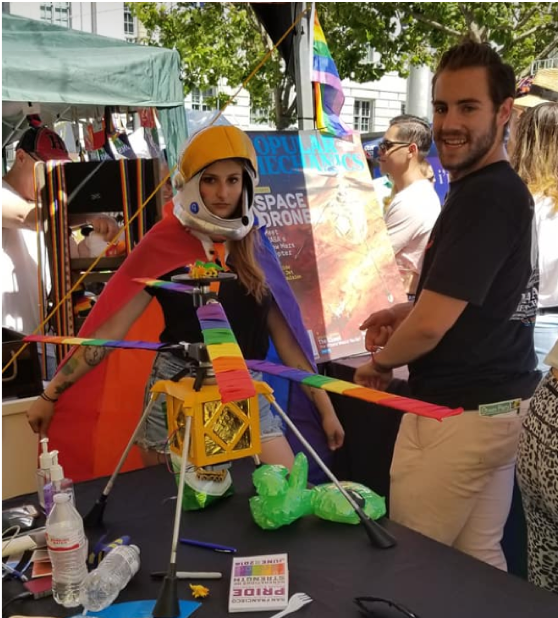
Fellowship opportunities for interested and highly motivated students include experimental projects conducted in the Ames 7- by 10-Foot Wind Tunnel, full-scale helicopter or tilt rotor tests in the National Full-Scale Aerodynamics Complex (the world's largest wind tunnel), and in flight with resident U.S. Army UH-60A Black Hawk helicopters. Analytical research projects include new vertical lift aircraft assessment and analysis (manned and unmanned), comprehensive analysis of current and new helicopter and tilt rotor aircraft, as well as CFD modeling of rotary wing systems and airfoil aerodynamics. Many of these projects include collaboration with the Department of Defense (U.S. Army, DARPA) and the U.S. helicopter industry.
Some of the student design and internship opportunity announcements are listed below. To learn more about student opportunities at NASA, interested applicants should apply through the NASA Internships and Fellowships.
NASA Internships and Fellowships
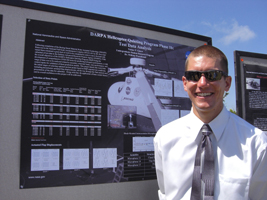 NASA Internships and Fellowships is a nation-wide system for the recruitment, application, selection and career development of undergraduate and graduate students primarily in science, technology, engineering and mathematics disciplines. Opportunities for students in other disciplines are available. The NASA Internships and Fellowships application is a year-round program and has a variety of time frames available.
NASA Internships and Fellowships is a nation-wide system for the recruitment, application, selection and career development of undergraduate and graduate students primarily in science, technology, engineering and mathematics disciplines. Opportunities for students in other disciplines are available. The NASA Internships and Fellowships application is a year-round program and has a variety of time frames available.
Students have the ability to search and apply for all types of NASA internship, fellowship, scholarship opportunities in one system. A single internship or fellowship application places students in the applicant pool for consideration by mentors for all NASA internships or fellowships.
NASA Internships and Fellowships provides a flexible workforce solution for Sponsors while enabling students and faculty to contribute their specialized skills and grow their knowledge while at the same time gaining practical experience in their chosen field or career pathway.
For more information about this opportunity, visit: NASA Internships and Fellowships
